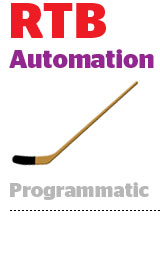 MAGNA GLOBAL Research has issued a new report this morning chock full of data that shows robust growth in programmatic buying of digital media.
MAGNA GLOBAL Research has issued a new report this morning chock full of data that shows robust growth in programmatic buying of digital media.
For starters, the company says that in the U.S. programmatic inventory (display, mobile, social, video) will hit $7.4 billion this year. Of that, $3.9 billion will be real-time biddable, which $3.5 billion will represent sales by “non-RTB” platforms.
More from the release:
- “We forecast robust growth as more publishers, advertisers and agencies embrace programmatic technologies. As a result, the volume of transactions will grow to $17bn by 2017 in the US, of which $10.5bn will be RTB-based.
- RTB-based programmatic will grow from 28% of display-related* transactions this year, to 52% by 2017.
- In our first analysis of the programmatic marketplace outside the US, we find that the share of RTB and programmatic, as a % of display-related formats, is and will remain lower than the US’s, but it will approach 60% in markets like the UK, France and the Netherlands.
- For online video formats, programmatic trading has been lagging behind display in recent years, but MAGNA estimates that this year 25% of the inventory will be traded programmatically, and that proportion should climb to 69% in 2017.
- Globally, over the 9 key markets surveyed by MAGNA GLOBAL, programmatic buying already represents $12bn in 2013 and will nearly triple in the next four years to $33bn.”
Search not included: A number of industry observers looking over MAGNA’s programmatic predictions wonder what is being counted in the researcher’s report. In particular, what about paid per click advertising in search? Technically, you could consider PPC the “original” form of programmatic, said Vincent Letang, MAGNA’s EVP/Director of Global Forecasting and the report’s author. But the purposes of the report are intended to show the evolution of display, not online advertising generally.
“Of course PPC Search can be considered programmatic, although the methods of targeting are different, it was the first fully computerized advertising trading platform working on an RTB principle,” Letang said. “Since 100% of search has been ‘programmatic’ from birth, our report is focusing on ‘display-related’ instead, and the penetration rates in the report are based on total ‘display-related’ advertising (banners, social, video, mobile). But you’re right that if we had included Search, the rates would have been a lot higher since search is roughly 50% of total digital media advertising.”
RTB vs. Programmatic Direct: One of the paradoxes of display advertising is that, like anything that happens online, it is inherently computer-based but it has generally been transacted like traditional advertising. The rise of RTB has changed that, but as Letang noted, RTB is still a small part of the business. Ultimately, when it all shakes out, there will still be this 20% of display advertising that remains outside automated channels, such as native advertising, home page ads and anything else that resists standardization and requires an actual personal touch in terms of timing and placement.
That said, the rise of programmatic direct, which can include automating much of the workflow processes that go into one-to-one (or one-to-a select few) advertising in the form of publishers’ private marketplaces has changed that to some extent. This model tends to resist the immediate prerequisites of RTB and its general use for direct response ads. The idea of automating branding campaign advertising and guaranteed ad sales has been starting to take hold.
The drive behind programmatic direct is largely coming from the growth in social and mobile advertising, particularly Facebook’s activities as a dominant display player right behind Google.
“It’s true that some forms of online display will not migrate to RTB,” Letang said. “The way it’s traded will change. Non-RTB programmatic display sales can encompass certain workflow elements between agencies and sellers outside the purposes of real-time needs. It can take advantage of automatic reporting and external data being plugged in. That all qualifies as programmatic.”
Nevertheless, Letang is doubtful that despite the wider adoption of programmatic by all sides of the industry, programmatic will account for more than a small part of automated buys, as true “premium” remains a hands on business.
Higher RTB, Lower CPMs: One of the chief complaints from the sell side is that RTB actually means “race to the bottom,” since the buyers are competing from low bids for inventory that publishers have trouble selling. As Steve Goldberg, a senior advisor to Empirical Media, wondered what effect the growth of RTB would have on pricing. “How much revenue will the 52% of transactions [that go programmatic] generate?”
MAGNA doesn’t forecast prices related to RTB and programmatic, but Letang acknowledged that CPMs will likely erode as more inventory becomes biddable.
“In theory, programmatic in general and the RTB format in particular will add greater scale to the instant meeting of supply and demand,” Letang said. “So that does reduce the price. Now it’s possible that, in some cases, by revealing the true value of certain inventory, CPMs will not go down. The demand might be bigger than a seller might anticipate and as demand rises, so do prices.”
Still, that’s likely to be atypical of what happens to prices in a more programmatic world. But Letang said there is an upside for sellers that goes beyond CPMs.
“Everyone in the value chain is ready to accept lower CPMs, as long as publishers also see a reduction in transaction and insertion costs and that they’ll be able to sell a greater portion of their inventory,” Letang said. “Plus, programmatic can free up more time for the human side of the business to concentrate on selling more high value deals and solution, maximizing the return on investment.”
Video’s slow rise: Although the video ad space has appeared extremely hot lately and many ad tech providers have expanded their respective video marketplaces, this area has been slower than most parts of display to embrace programmatic, though as the numbers above show, that’s rapidly changing.
For 2013, MAGNA’s research sees about 25% of video inventory being traded programmatically. By the time 2017 ends, MAGNA expects 69% of video ads to be bought and sold that way.
One reason video has dragged in adopting programmatic is because some of the biggest online players, like Hulu, have dominated much of the ad sales. “The broadcast networks have tended to bundle their online video inventory with their TV inventory and both are sold using traditional ways,” he said. “But there is an increasing willingness on the sell side and buy side to explore innovation in deal making. But video also falls into the ‘premium’ inventory, such as branding. As such, video ad sales will become programmatically traded, but it will be a slow adoption, not a rapid one.”
Mobile gets going: This year, 58% of desktop display is traded programmatically, compared to 68% for mobile. By 2017, we expects the two sides to be fairly even when it comes to programmatic, as 87% of desktop ads are processed via automated channels with 88% of mobile inventory being handled that way.
But that may say more about the diminishing value of cookie-based third party data and first party data, which is not reliant on tracking pixels.
“The shock about mobile advertising growth at the start of the year when Facebook earnings revealed that the company’s mobile revenues were rising much higher than expected,” Letang said. “The intersection of social and mobile advertising is programmatic. While the Facebook Exchange is relegated to the desktop ads and has little to no mobile inventory, the company primarily sells its inventory using largely programmatic methods. That success will point the way for others, as social will also drive the increased use of first party data for digital ad sales.”













